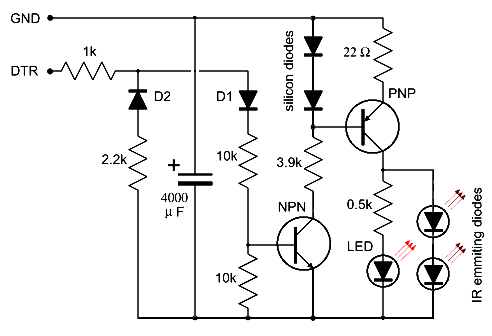

Simple signal-powered, middle-range infra-red transmitter

How it works:While the computer serial device is open and idle, DTR is negative w.r.t. GND and the large 4000 µF capacitor gets full charge through D2 and the 2k2 resistor in a few seconds. Meanwhile, the input to the NPN transistor remains blocked thanks to D1. As IR commands are sent to the serial device, positive pulses arrive to DTR. These pulses have no effect onto the capacitor, since they are now blocked by D2. While the capacitor has enough charge, it powers the couple of NPN/PNP transistors, which behave as a simple conventional pulse current amplifier. They yield enough (pulsed) current to the pair of infra-red diodes to allow mid-range operation; typically beyond 5 meters. The (optional) red LED and 0.5k resistor are intended for visual monitoring of the outgoing IR bursts. Obviously, the current pulses tend to quickly discharge the capacitor, but 4000 µF can hold enough charge for regular typical operation with most IR commands, even in those cases where bursts are repeatedly sent while button-pressed. Fortunately enough, even in these repeated-burst situations, the serial device is in fact idle most of the time, thereby allowing the capacitor to recover its charge and be prepared for powering new pulse bursts. Notes:Any type of low/medium-power diodes and transistors are suitable. The only critical components (apart from the IR diodes themselves) are the two voltage offset diodes. These diodes are marked as "silicon", meaning that they must be "normal" silicon diodes, which have a significant offset voltage (+0.7 volt, approx.). Other kinds of diodes (e.g., germanium diodes) may have much lower offset and are inadequate for the intended purpose. Tolerances are not critical for any component of this circuit (±10% or even ±20% should be ok). Of course, the range depends on how much power is applied to drive the IR diodes and of the type of diodes themselves. I have tested several kinds of IR diodes (intended for standard remotes) with no much difference. As to the power, it depends on two main factors: a) the value of the (22 Ohm) resistor from GND to the emitter of the PNP transistor and b) the large (4000 µF) capacitor. The range can always be increased by lowering the value of the resistor (and/or adding more IR diodes) but than the value of capacitor needs to be increased correspondingly. |